
Large amounts of infrared light may be detected as heat. The heat you feel from a fireplace, sunlight, or the ground are all sources of infrared light. The eyes of some living creatures, like the rattlesnake, are sensitive to infrared light. Thus, they see very small temperature variations in their environment. However, the amount of infrared light coming from a remote conrol is very small, so we do not feel any heat.
Sometimes remote controls fail to function correctly. The first check that is made by repair people is to see if the remote control is emitting infrared light. Of course, the repair people cannot see infrared light and carrying around rattlesnakes is considered impractical.
Fortunately, a small material enables them to "see" indirectly the infrared light. This IR detecting material converts infrared signals to visible light. At first the process may seem similar to fluorescence because it is converting light of one energy to light of another energy. However, IR detection is different from fluorescence in one very important way. In fluorescence a solid emits a lower energy than it absorbs; the rest of the energy goes to other forms. In IR detection, the material is emitting higher energy than it absorbs. This process is described graphically below.

The difference between fluorescence and infrared detection is in the changes in the energy of photons. We have included a question mark because you do not yet know how the energy changes in the IR detection process.